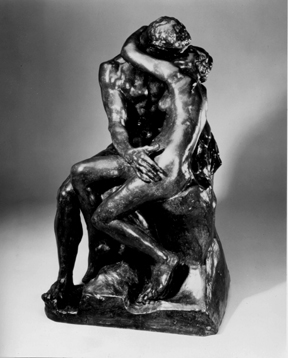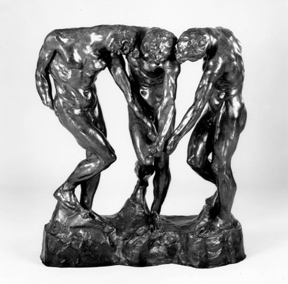Rodin:
A Magnificent Obsession
at
the Albany Institute of History & Art
By
RAYMOND J. STEINER
ART TIMES November 2005
“…A
LOVER WHO could not be resisted.” So said Rainer Maria Rilke in his
love/hate paean* to Auguste Rodin (1840-1917) written during his extended
stay at Meudon as personal secretary beginning in 1902 and ending in
1906, when, also according to Rilke, he was “dismissed like a thieving
servant.” In truth, so much has been written about Rodin that it is
somewhat of a problem to get beneath the anecdotes, the lionization,
the reams of adjectives that have been lavishly strewn in his wake by
admirers and detractors (both those who have known him and those who
have not) to get to see the man behind the mythos that has grown up
around him. In the end, of course, it is less the man than his work
that matters most to us and, with some 70+ bronzes — from maquette-sized
studies to monumental works — the present exhibit at the Albany
Institute of History & Art* affords an exceptional opportunity for
us to come away with a more than adequate impression.
|
|
To
begin with, organized as they are into related themes (“The Gates of
Hell”; “The Burghers of Calais”; "Balzac”; “Hands”; etc.) spread
throughout the half-dozen or so galleries devoted to the exhibition
makes for easy viewing — the order imposed certainly nothing like
Rodin’s studio and grounds which, like many sculptor’s environs, had
more the hodge-podge appearance of disorder found in used car lots.
Secondly, a certain amount of order is also imposed in view of the fact
that these pieces represent the individual tastes of collectors, viz.
Iris & B. Gerald Cantor whose foundation both organized and
made possible the exhibit (funding and support was provided by Sponsor
First Albany, Omni Development Co., Inc., Lois and David Swawite, M&T
Bank, and Mountain View Group). Nevertheless, ignoring the artificial
categorizations and taking the time to study Rodin’s works as discrete
entities does leave the viewer the freedom to come away with a personal
impact.
In
point of fact, many of the works included in the exhibit are indeed
discrete pieces — in one instance just hands, in others, partial
figures — each, however, capable of standing on their own as complete
and integrated works of art, such being the potent power of Rodin’s
ability to “speak” through his creations. The question is whether in
partial or monumental completion, what does his work say?
For
this viewer, I come away with considerable disquiet inasmuch as a great
deal of Rodin’s work seems to bespeak an unclear vision of just what
the human figure is. Certainly he does not ascribe to the Greek
ideal or its offshoot, Italian Renaissance art, with their belief in
the perfection of man. This is not to say that he cannot follow in the
very large footprints that they left in Western art — every so
often we come across in the exhibit what may be called for lack of a
better term, “finished”— that is to say, with a “polished” exterior
such as that in “Idyll of Ixelles” or “The Sirens” (Cat. Nos. 13, 89,
respectively) as well, of course, in pieces not included such as “Fallen
Caryatid with Stone” (Cat. No. 142), “Mme. Morla Vicuña” (Cat. No. 147)
or “Thought” (Cat. No. 131) all carved a la Carpeaux from marble, the
first a promised gift to the Cantor Collection, the other two in the
Musée Rodin, Paris. The latter examples are, as noted, carved from marble
and by all indications Rodin’s preference was for modeling his pieces
in lumps of clay.
Perfection
in the human figure, in any event, seems not to be Rodin’s ultimate
vision of mankind. Instead, his “magnificent obsession” appears to show
mankind in a state of becoming, a state of striving toward some completion
that he cannot as yet foresee. Figures are not only contorted into “inhuman”
shapes, but often far from anatomically correct. Abnormally elongated
limbs and necks or an awkwardly realized upper torso in, e.g., “Jean
d’Aire, Nu” might give rise to the mistaken belief that the artist simply
doesn’t know any better. Rodin’s figures — whether real or imagined
— are not, properly speaking, “beings” at all, but rather rough
drafts of them. For all its apparent order, strolling through this exhibit
is like wandering through some earlier prototype of Eden in which a
confused Creator is hastily lumping earth together and still seeking
his ultimate “intelligent design”. That Rodin knew his anatomy, however,
can clearly be seen not only in those pieces more classically executed,
but also in his drawings, several of which are in the exhibit (see especially
the engravings “Antonin Proust”, and “The Ring” (La Ronde).
Even
taking into account that many of the studies in the exhibit were intended
for his masterwork, the “Gates of Hell”, in which convulsed figures
seem de rigueur, one looks in vain to find classical beauty in
his modeled works. One can only assume, therefore, that Rodin’s figures
are exactly what he intended them to be — a realization that becomes
even clearer when we see the several studies that often precede final
versions, a fact made especially evident in the “Balzac” gallery and
the variations he went through before settling on the Balzac he envisioned
(“envisioned” since Rodin never actually met the great author). In no
instance do we find a hint of idealization.
Yet,
if we cannot find classical beauty, there is little doubt that
we find another kind of beauty — that of Michelangelo’s terriblita,
a kind of overpowering grandeur that lies at the heart of raw creativity,
that creative cauldron from which all art arises before it is imprinted
(and modified) by human consciousness. Indeed, many of Rodin’s pieces
are reminiscent of the great Italian sculptor’s half-finished works,
those awesome figures forever encased in and breaking free from their
stony origins. The impact of Rodin’s vision of ‘dead matter coming to
life’ is most vividly experienced in the monumental conceptions, several
of which (“Fallen Caryatid with Stone” (so different in aspect from
the work of the same name carved in marble), “Whistler’s Muse”, and
the especially awe-inspiring though partial “Monumental Torso of the
Walking Man” — this last, it seems to me, to sum up Rodin’s true
genius of forcing his viewer to see man in all his awesome “becoming”.
|
|
In
a sense, from what we know of Rodin the man, his bronzes — his
gallery of prototypical human forms — might be seen as an extended
self-portrait. Rough-hewn and often ill at ease with his Parisian sophisticates,
Rodin made little effort to exude a “polished” surface himself. He knew
himself also to be not yet fully realized, a living example of the work-in-process
— the human being who still has to grow into his idealized state.
This
is a rare occasion for not only upstate-New Yorkers, but for all those
who do not anticipate a trip to France in the near future to get a close-up
look at the work of one of the major figures in the annals of modern
art. While you’re visiting “A Magnificent Obsession”, take the time
to watch the 53-minute award-winning video, “Rodin: the Gates of Hell”,
that presents a dramatic showing of the 10-step lost-wax casting process
that chronicles the project. This is a show you ought not miss, and
kudos to all those who made it possible as well as to the Albany Institute
of History and Art for taking the time to present it to the public.
*Auguste
Rodin: Rainer Maria Rilke. (Archipelago Books, 2004. Translated
from the German by Daniel Slager). Pgs. 73, 26.
**“Rodin:
A Magnificent Obsession, Sculpture from the Iris & B. Gerald Cantor
Foundation” (thru Dec 31): Albany Institute of History & Art, 125
Washington Ave., Albany, NY (518) 463-4478. A fully-illustrated catalogue
is available: Rodin: A Magnificent Obsession by Kirk Varnedoe
et al. 192 pp.; 9 ½ x 11; B/W & Color Illus.; Checklist;
Index. $29.95 Softcover.




